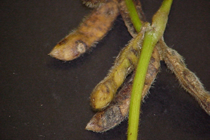By Loren J. Giesler, Former Extension Plant Pathologist
Pathogen
Anthracnose of soybean is caused by the fungus Colletotrichum truncatum. This is the most common species associated with this disease, but several other Colletotrichum species have also been identified to be involved. The fungus produces crowded, black acervuli on infected tissues. This will be dark bodies looking much like "pin cushions" on the plant surface when viewed with 20X or greater magnification. Acervuli produce many spores (conidia) which is how the disease spreads.
The fungus overwinters in infested crop debris and has been shown to be seedborne.
Disease Symptoms
When infected seeds are planted pre-emergence and post-emergence damping-off may occur. Sunken, dark brown lesions develop on the cotyledons of seedlings. Seedling lesions may expand to the stem and kill young plants.

Plants may become infected at any stage of development, but in Nebraska, chances of infection tend to increase with maturity. The most common symptoms are brown, irregularly shaped spots on stem, pods and petioles. The girding of petioles by large lesions results in premature defoliation. When pods are infected, mycelium may completely fill the cavity and no seeds are produced (pod blanking) or fewer and/or smaller seed form. Seed that does form may appear brown, moldy and shriveled or may look normal. Dark acervuli develop in lesions on all host tissue areas. Leaf infections result in leaf rolling, necrosis of laminar veins, petiole cankers and premature defoliation.This disease is commonly observed on soybean stems at maturity.
Favorable Environmental Conditions
Anthracnose infections typically occur during warm, moist weather. Infection typically occurs when plant leaf wetness, rain or dew periods exceed 12 hours per day.
Management
Cultural Practices
Anthracnose is a common secondary disease in Nebraska and management is not typically warranted. Crop rotation and crop residue incorporation will reduce inoculum by breaking down infested residue.
Chemical / Biological Control
Seed treatment fungicides should be used on seed planted from fields with high levels of anthracnose. In the southern US foliar fungicide applications have been shown to be an effective way or reducing late season anthracnose.
NebGuides
Seed Treatment Fungicides For Soybeans (G1852)
Foliar Fungicide Use In Soybean (G1862)
Additional Resources
North Central Soybean Research and Information Initiative: Anthracnose
